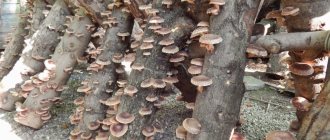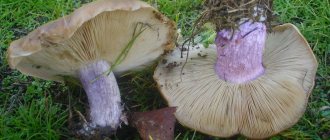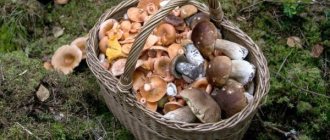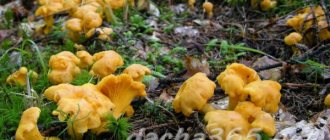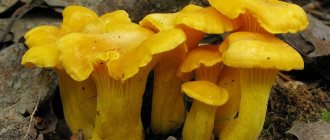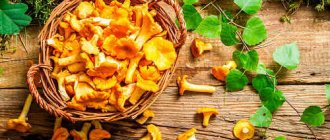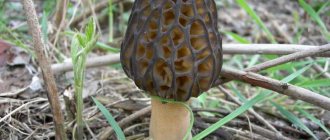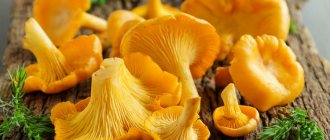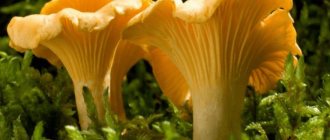In terms of nutritional value, chanterelles are in no way inferior to meat.
But, unfortunately, Russian forests do not always please the mushroom picker with rich catches. The way out of the situation is simple. You need to learn how to grow chanterelles in the country. Yes, this idea will seem crazy to some. However, imagine what a pleasant surprise it will be if it is successful.
I hope this article will help you in realizing this ambitious project.
Chanterelle growth conditions
In their natural growth environment, chanterelles form a mutually beneficial symbiosis with the root systems of various trees, receiving from them water and micro- and macroelements necessary for growth. Instead of what is received, the mushrooms saturate the tree with useful substances from their own chemical composition, so in order to achieve the most productive cultivation in artificially created conditions, you will have to take care of the availability of suitable overgrown tree rhizomes.
As an option, you can place the mushroom mycelium next to any coniferous tree on the site, but it is best if it is a pine or spruce, slightly shading the chanterelles (they do not like bright sunlight). Neighborhood with fruit varieties will not bring the desired result, since they are not suitable partner trees for chanterelles.
Important! If the planting material was taken from the forest and was previously located under a spruce tree, then at home it is better to place it next to this tree.
This way the mycelium will take root better and give a richer harvest. If there is no “neighbor” suitable for mushrooms on the site, you can move here a small spruce dug out of the forest along with roots and mycelium. In this case, the chances of successful survival of planting material and a future rich harvest are much greater. The ideal temperature for mushroom germination is +20...+28 °C, but in order for the mycelium to survive and produce a harvest, it is important to maintain constant values of at least -2 °C.
Of course, it is not always possible to achieve such conditions in an open area, which is why some mushroom pickers prefer to grow chanterelles only in greenhouses or cover recently transplanted mycelium for the winter.
Video: How to grow chanterelles on your own plot
Breeding at home for beginners
Unfortunately, at the moment it is not possible to grow these unique mushrooms indoors. After all, even breeding in laboratory conditions has not yet brought any results.
The reason is that chanterelles grow in close proximity to the roots of trees, with which they have a mutually beneficial neighborhood. If there is no suitable tree species on your garden plot, you can plant young seedlings.
For growing mushrooms in the basement, oyster mushrooms or champignons are more likely to be suitable. It makes no sense to grow chanterelles artificially in an apartment or cellar.
Selection of planting material
When choosing suitable planting material for chanterelles, first of all, you should focus on the type of future symbiont tree growing on the site. It is from the same type of plant that it is worth taking the mycelium from the forest, and it must be healthy, strong with a green crown (from the trunk to the crown).
Among the most popular types of planting material of the mentioned mushrooms are the following:
- caps of old specimens (including dried ones);
- spore infusion;
- cut off upper parts of the substrate removed next to the forest partner tree;
- mycelium dug out in a natural place where it grows.
Obtaining spore infusion and chanterelle caps will not take much time, but preparing the top layer of the substrate, with the mycelium present in it, requires longer processing, with keeping the removed soil in a dark room during the winter season at a temperature not lower than +8 °C. To prevent the mycelium from deteriorating, you will have to maintain the humidity of the substrate.
If you decide to breed chanterelles on your property with spores of this fungus, then there are several ways to “infect” the area:
- In the first option, you first need to soak mushroom caps collected in the forest in a bucket of sweetened water (for at least 10–20 hours). After the specified time has passed, the contents of the container are kneaded with your hands and the mixture is filtered through cheesecloth, then the water with spores is poured under the selected tree and a paste of solid parts of the mushroom body is placed on top (the top soil layer in the selected area is first removed and the soil is disinfected with oak bark tincture).
- The second option involves harvesting mycelium (thin white threads in the ground), collected next to a symbiont tree growing in its natural environment. It is worth digging up the mycelium along with part of the soil in which it is located, after which the planting material is moved into loosely tied bags with constant air access and left for the winter in a cool place (for example, in a cellar). With the arrival of spring, the prepared mycelium can be planted in the intended place.
Important! The presence of sugar in the soaking liquid is a prerequisite when preparing chanterelle planting material, since it is this substance that ensures the increased nutritional value of the solution and the further productivity of the spores themselves. Sugar is added to water at the rate of 100 g per 1 liter of liquid.
In the simplest version of preparing “seeds,” you can immediately chop up whole collected mushrooms and pour them with sweet water for 7 hours, after which all that remains is to fill the holes organized in the prepared soil with the resulting product (it is advisable to cover them with pine needles, fallen leaves, or even grass collected in the forest) .
Beneficial and harmful properties of chanterelles
These mushrooms are characterized by a rich composition, which determines their valuable properties. Chanterelles have the following actions:
- cleanse the liver of parasites and normalize its function;
- help improve a person’s condition in the presence of hepatitis;
- effectively fight infections with bronchitis, sore throat, furunculosis;
- promote weight loss;
- eliminate irritability;
- improve vision;
- reduce blood cholesterol levels;
- improve the activity of the thyroid gland;
- increase immunity;
- normalize blood pressure;
- suppress the growth of cancer cells;
- strengthen blood vessels;
- influence the formation of elastin and collagen;
- regulate the concentration of glucose in the blood;
- promote the breakdown and digestion of food;
- protect the body from stress;
- remove toxins from the body;
- normalize heart rate;
- improve joint mobility.
For medicinal purposes, chanterelles are consumed in powder form or fresh: boiled or fried mushrooms lose most of their valuable properties.
Despite the benefits of chanterelles, certain categories of people should not consume them. So, contraindications to their consumption are:
- periods of pregnancy and breastfeeding;
- individual intolerance to mushrooms;
- children's age up to 7 years.
Those who suffer from diseases of the gastrointestinal tract should treat mushrooms with special caution, since chanterelles are a difficult-to-digest product. If you have kidney disease, you should also limit your consumption of chanterelles and other types of mushrooms.
Despite the fact that most types of chanterelles are edible, they can still cause harm to health if they were collected near existing industrial enterprises or large highways. In such places they accumulate large amounts of heavy metals and other harmful substances.
Preparing the landing site
Having chosen a suitable place on the site for planting chanterelles, it is worth removing all plant debris from the surface and removing the top part of the soil itself (2-3 centimeters is enough). A few days before planting mushrooms, the substrate must be well moistened by first adding an infusion of oak bark to the rainwater for irrigation, which can effectively disinfect the soil and create a favorable microclimate for growing mushrooms.
Also find out how long fresh chanterelles last in the refrigerator.
You can buy the nutritional supplement ready-made in pharmacies, or you can prepare it yourself by pouring boiling water over cut tree bark for several hours. On the day of planting, it won’t hurt to additionally shed the soil with bark infusion; the main thing is to dig a hole in advance with a diameter of 50–60 cm and a depth of 20–30 cm, in which the mycelium will multiply.
The use of chanterelles in cooking and medicine
Chanterelles are suitable not only for preparing various dishes based on them, but also for making medicines.
Chanterelles in different dishes
Chanterelles have high taste qualities, so they are included in various dishes.
Before cooking, the mushrooms are processed: thoroughly washed and then dried. After this, the roots of the chanterelles are cut off and the soil is scraped off, and the broken edges of the cap are cut off.
You can store chanterelles in the refrigerator for no longer than 2 days, as they spoil quickly. Under no circumstances should they be placed in plastic bags, as the mushrooms will suffocate in them and become moldy.
The following delicious dishes are prepared from these mushrooms:
- mushroom soup;
- vegetables baked in the oven with chanterelles;
- pie with cheese and mushroom filling;
- pilaf with chanterelles;
- fried potatoes with mushrooms;
- spaghetti with mushrooms;
- creamy sauces with pieces of chanterelles;
- buckwheat porridge with fried chanterelles;
- omelette with mushrooms.
Chanterelles can also be pickled for the winter and frozen. It should be remembered that freshly frozen mushrooms are stored in the freezer for no longer than six months. Dried mushrooms in powder form can be stored for a year.
The use of chanterelles in the manufacture of medicines
Due to their medicinal properties, chanterelles are also used to prepare remedies for various diseases.
Most often, the following medicinal compositions are prepared based on these mushrooms:
- Tincture against helminths. To cleanse the body of parasites, you need to prepare the following remedy: dry the chanterelles and grind them into powder, take three tablespoons of the resulting raw material and pour in 300 ml of vodka. The container should sit for 3 weeks in a cool, dark place. It is necessary to shake the bottle periodically. You need to take 20 ml of tincture in the evening. The duration of treatment is 14 days.
- A means to improve vision. To prepare, take 10 g of dry chanterelle powder and two glasses of water. Pour boiling water over the powder and place in a water bath. Boil for a quarter of an hour, remove from heat and leave for an hour. There is no need to strain the finished broth. Take it cooled three times a day before meals, a dessert spoon. During one course of treatment you need to drink about 3 liters of mushroom broth.
- Decoction for cleansing the liver. To prepare, take a tablespoon of fresh chopped mushrooms. Mushrooms need to be poured with boiling water (one and a half cups). Put it all on the fire and cook over low heat for 20 minutes. Next, remove the mixture from the heat and leave for 4 hours. Strain before use. Take a tablespoon 4-5 times a day, 40 minutes before or an hour after meals.
- Chanterelles are recommended for consumption by those who want to lose excess weight. To do this, you should introduce dried mushroom powder into your diet. You need to take it one teaspoon twice a day with water.
Before using chanterelles for therapeutic purposes, you should consult your doctor to make sure there are no contraindications.
Chanterelle mushrooms grow in forests. They can also be grown on your own plot of land in a home farm, but only extensively: such mushrooms do not grow in greenhouses. Based on chanterelles, you can prepare various dishes and medicinal compositions for various diseases.
0
0
Copy link
How to plant chanterelles
To plant chanterelles, you should choose a clear and fine day at the end of spring or early summer, when the weather has already become warm outside, but the air humidity is still high.
The step-by-step implementation of planting activities can be presented in the following diagram:
- To begin, generously water the prepared area with oak bark infusion (especially if you have not done this before).
- Then, after the liquid has been completely absorbed, place the seed from the prepared slurry on the bottom of the prepared hole and distribute it evenly along the bottom of the hole (this is how mushrooms are most often planted).
- Fill the hole with earth and lay forest grass, pine needles or leaves on top.
Moisten the planting without allowing the soil to dry out during the entire further period of growing mushrooms. The optimal humidity levels at the initial stages of cultivation are at least 40–50%, but during the fruiting season of chanterelles they can be increased to 80–90%, which even a beginner can cope with by watering.
Industrial farming as a business
There are two ways to grow mushrooms: extensive and intensive. The first involves growing mushrooms in natural, natural conditions in the country or near the house. It is quite suitable for breeding a species such as chanterelles.
Disadvantages are also possible, such as the seasonality of mushroom picking and the size of the harvest, which directly depends on climate conditions. This propagation method does not require large material costs.
The second way is intensive. This breeding method is more suitable for mushrooms such as oyster mushrooms and champignons. There is no intensive method (in a greenhouse) for growing chanterelles. For the reason that for these fungi, natural conditions, air temperature and the proximity of trees with whose roots they form mycorrhiza are a prerequisite for reproduction. After all, it is from the roots of certain trees that chanterelles feed on the necessary moisture and substances necessary for growth.
Growing and care
Like most mushrooms, chanterelles love moist soil, so once every 7 days you will have to water the mycelium from a watering can with a sprinkler attachment, reducing watering only during prolonged rains. 2-3 weeks after planting the chanterelles, carefully lift the top covering layer (from forest grass and pine needles) and make sure that the mycelium is viable, which should stretch through the soil with purple threads with a greenish tint.
You should not dig up the soil in the planting areas, otherwise there is every chance of disturbing the structure of the mycelium, and complex mineral compositions for garden vegetation can be used as fertilizer. To tell the truth, mushrooms do not really need fertilizing and, if there is a symbiont plant, they can be grown even on “lean” soils.
In preparation for the winter season , the mycelium placed on the site must be covered with hay or dry branches, expecting the first harvest next year. With the onset of stable spring warmth, excess top cover should be removed, thereby providing the mushrooms with space for further growth.
When to expect the harvest
The first chanterelles will appear on the site a year after planting. Harvest guarantee - proper care. To allow the mycelium to overwinter, cover it with hay, leaves or branches. In the spring, when warm weather sets in, remove all excess from under the tree to give the mushrooms a chance to grow.
Do not dig up the soil around the tree; provide rest for the mycelium. It’s wonderful if grass brought from the forest grows on the mycelium. Be patient, because the reward for your hard work is delicious chanterelles grown on your own plot.
About the benefits of chanterelles
Chanterelle is rich in vitamins, microelements and amino acids. The bright red color of carrots is due to the high content of beneficial carotene. The mushroom is used in the prevention of various diseases, in the treatment of liver, hepatitis C, and eye diseases.
Chanterelle helps fight inflammatory processes, inhibits the growth of many pathogens, and improves immunity. Just a couple of decades ago it was an ordinary mushroom, widespread in our forests. Today, near large cities, chanterelle has become a rarity, as well as other valuable mushrooms.
Common chanterelle. © Strobilomyces
Growing technology: spores or mycelium?
By preserving or growing oak, beech, and pine in your dacha again, you can sow a colony of chanterelles.
Controversy
You will need fresh old mushroom caps. This material is saturated with mature spores, from which you can prepare a spore infusion. To prepare it, old caps are soaked in a bucket of rainwater for several hours to a day. It is also recommended to add 50 g of granulated sugar. Then, the chanterelle caps are kneaded well, in the same bucket, until a homogeneous viscous mass is obtained. The resulting solution is filtered through cheesecloth, without throwing away the mushroom mass remaining on it.
Near the trunk of the selected tree, the top layer of earth is removed to a depth of 10-20 cm and a diameter of about one and a half meters. As a disinfectant, the resulting open area is spilled with a decoction of oak bark (30 g of bark per 1 liter of water, boil for 1 hour, add water when boiling). One tree will require about 2-3 liters. After waiting 2-3 hours, the solution with spores is poured onto the roots of the tree, and the remaining mushroom mass is laid on top. The infected area is covered with a previously removed layer of soil. Water abundantly along the tree trunk (so as not to wash away the soil), about 4-5 buckets. Subsequently, the sowing sites are maintained in a moist, but not soggy state, which is optimal for growing chanterelles.
Popular articles Description of Russula stinging beetle
Mycelium
In practice, this method provides the best results, ensuring accelerated adaptation of “wild” chanterelles to growth and development at home.
Harvesting chanterelle mycelium is best done in March-April or August. In the forest located not far from the dacha, you need to choose a place where the desired mushrooms definitely grew
It does not matter whether they are present at the time of harvesting the mycelium - the chanterelles may not have grown fruiting bodies due to inappropriate weather, but their mycelium, hardy and protected from the surface by a layer of soil and forest litter, still retains viability sufficient for growing fruiting bodies
From a site located near a suitable tree - healthy and strong, with a green and not drying top, of the same species as the dacha tree - you should dig up pieces of forest soil 20-30 cm long and wide, 15 cm thick. Each such layer is divided into 5-10 fragments are placed in open containers - untied bags, buckets without lids - and put away in a cool cellar or basement until the next summer season. During this period, the prepared soil will dry out, competing soil organisms will die, but the chanterelle mycelium will survive - it is able to resume growth even after 15 months of such storage.
At the end of June, fragments of soil with mycelium are planted for cultivation. Around a friendly trunk, they dig holes with a diameter of 10 cm and a depth of 20 cm, then the harvested forest soil is compacted tightly into them and watered from a watering can equipped with a nozzle with holes, so that a liter of water falls per filled hole. The soil around each planting is also moistened by pouring out at least 10 liters of water, and then covered with a layer of pine needles, branches, moss, and fallen leaves.
Further care comes down to timely and sufficient soil moisture. During the dry season, each tree intended for growing mushrooms is given at least 3 buckets of water weekly. The first harvest of young, established chanterelles should be expected next summer. In a warm and humid spring, their bright fruiting bodies can ripen as early as late May.
Chanterelles, which develop in close symbiosis with trees of certain species, can be grown at home by properly preparing “wild” forest mycelium and providing it with the appropriate environment at their summer cottage. However, it is difficult to build a business with intensive cultivation on cultivated chanterelles, since their life cycle is closely related to the growing and dormant seasons of trees.
Growing in a greenhouse
We grow chanterelles at home.
Instructions for a beginner If you still firmly decide to grow chanterelles, then our editors have prepared for you detailed step-by-step instructions for cultivating this mushroom in your greenhouse. Following them, beginners will also not have problems.
Preparing the greenhouse
There is no need to build or buy a new greenhouse. An old greenhouse is suitable for cultivation, in the soil of which peppers, cucumbers or other vegetables or herbs were previously grown. To use an old greenhouse, you only need to install special shelving.
Additionally you will need:
- Install comprehensive lighting, high-quality ventilation and install an air conditioning system
- Made from chopped straw, dry grass, sawdust, manure, superphosphate with the addition of a small amount of water and gypsum
- Using fabric devices or mesh, create partial darkness. This manipulation will prevent sunlight from damaging the mycelium, and the compost will better maintain the required level of moisture.
- Provide the greenhouse with a humidity of at least 90% by installing an irrigation system
Expensive automatic ventilation and watering equipment is suitable for those who still want to cultivate chanterelles for commercial purposes. Pursuing the goal of providing your family and yourself with valuable and tasty mushrooms, you should still refrain from expensive investments and will have to do everything manually.
Secrets and subtleties of growing
- Use sawdust from the following trees for compost:
- Fir
- Beech
- Oak
- Pine
When these trees are used in compost, chanterelles will develop and grow especially well.
- The soil, when mixed with compost, should be slightly acidic, regardless of its location - on the ground or on shelves.
- The mycelium (chanterelle seeds) is sensitive to cold temperatures. For successful cultivation, heating must be provided. If you live in a climate zone where winter is not too severe, then you can cover the planting site with fallen leaves or moss for the winter. In spring, when the air warms up, the blanket should be carefully removed
If these points are observed, the harvest can be harvested after one year or a little earlier.
Chanterelle business plan
| Investments: 19,000 rubles | Income: 75,000 rubles |
| Quantity: 30 acres of land | Payback: 1-3 years |
Chanterelle is a popular mushroom that is used in various dishes. Having arranged plantings in the forest or on your own site, you don’t have to spend hours searching for them every year, but always collect them in one place. It will be profitable if you plant them in the right place over a large area.
Where to plant chanterelles on the site
Looking for chanterelles in coniferous forests
These fungi are mycorrhizal, meaning they cannot survive without close cooperation with certain trees. The best companions for a cockerel are any species and varieties of spruce and pine. It can also “make friends” with oak or beech.
But planting mushrooms in an orchard is useless. They still won't take root. In such a situation, you can move a young seedling from the forest. But just keep in mind that the fungus “partners” better with mature healthy trees. Therefore, you may have to wait a couple of years until the immigrant grows up.
The planting site is chosen in sparse shade, at some distance from the trunk. In addition, you need to make sure that there is enough space around so that the mycelium can grow freely.
Why are chanterelles grown at home?
We grow chanterelles at home. Instructions for a beginner
There are three main reasons why these mushrooms are grown:
- Business. Namely, sales to stores, supermarket chains and independent distribution
- Home cooking. Fans of mushroom cuisine sometimes grow this mushroom at home and delight themselves in the winter with the taste of fresh mushrooms, without fear of possible industrial impurities
- Use in folk medicine. Chanterelle has an excellent composition that helps in the treatment and prevention of various diseases. That is why healers and folk craftsmen grow it at home and use it to prevent many diseases
Let's look at each reason in more detail!
Business at home
We grow chanterelles at home. Instructions for a beginner
Let’s immediately say that it is almost impossible to do this in an apartment. You need at least 15 acres of land with the necessary conditions for growing:
- Suitable soil
- Presence of forest trees
Or, you need greenhouses and racks installed in them for growing chanterelles.
There are several negative aspects to growing them for business, namely:
- Seasonality (almost impossible to cultivate in a greenhouse in winter)
- Long payback period (it will be possible to collect the first harvest from sowing no sooner than in two years)
- The mushroom is grown in large quantities on an industrial scale
- A large number grows independently, in almost all forests of Russia
- Special conditions and equipment required
Based on this, we can conclude that it is worth growing it in large quantities, only in this case does this business make sense. The bulk of “store-bought” chanterelles are specimens that were raised on farms. The process of cultivating this mushroom is too thorough and expensive, so production on an industrial scale is carried out by farms, not factories.
For cooking and for use in folk medicine
We grow chanterelles at home. Instructions for a beginner
We, as well as many mushroom pickers, have controversial opinions on this matter. We believe that it is easier to collect them during the season and freeze them, or prepare them for later use using other methods. This activity can cause you too much effort and trouble.
But, if you have firmly decided for yourself that you will grow chanterelle mushroom at home or in the country, then below we will tell you step by step how and what you need for this.
As for traditional medicine, for these purposes the option of growing in a greenhouse will be the most correct for the reasons:
- The harvest will be 100% high quality
- You can't get poisoned by mushrooms from a greenhouse
- Chanterelles from a greenhouse will not be able to accumulate toxins.
For all these reasons, the greenhouse is a more suitable growing area for use in traditional medicine.
Types of edible chanterelle mushrooms, and what they look like in the photo
There are many varieties of edible chanterelles. They are difficult to confuse with other types of mushrooms. Their cap and leg have practically no distinction and merge into a single whole. By the non-standard shape of the cap and irregular edges, a fox is easily recognizable. The mushroom, the picture of which is presented in the encyclopedia, may differ slightly from that found in the wild, due to the climatic characteristics of the region in which it grew.
Real or common fox
The best of the chanterelle has been preserved in this subspecies. This mushroom can be found most often. It is practically not affected by worms, has a beautiful appearance, is easy to prepare, and has a universal purpose. The harvests are plentiful during the season, enough for all lovers of quiet hunting. And the real fox is one of the first to appear, the weather is unlikely to begin.
A real chanterelle is not fragile, it can be collected in any suitable container
These mushrooms do not need careful and reverent handling; they can be collected in a backpack, basket or ordinary bucket. Product quality will not suffer from this in any way. The mushroom contains a lot of carotene, which gives it a rich yellow color. The composition also contains a huge amount of substances beneficial to the human body.
It is worth noting that the chanterelle mushroom is beneficial to humans only if it is collected directly from the forest. Those specimens that grew near a road or city should not be eaten. Otherwise, you can get poisoned, since chanterelles, like any other mushrooms, perfectly absorb poisons and exhausts.
A real fox is never affected by worms
The real chanterelle is not affected by worms due to its chitinmannose content. They have learned to successfully isolate it and use it for medical purposes. Fruiting of chanterelles begins in mid-summer and continues until the first frost. They very rarely grow alone; mushroom pickers most often encounter entire paths or small clearings.
Trumpet chanterelle and conditionally edible black chanterelle
The trumpet chanterelle is a conditionally edible mushroom. It grows to a small size, at a young age it has a smooth or even convex cap, but as it ages, its shape becomes funnel-shaped. Eventually, the mushroom becomes like a tube. The hat is only 1-4 cm in diameter, its edges are fairly curled. The color at maturity becomes yellow-brown and rather dull.
The trumpet fox has a thin leg and a small cap.
Tubular chanterelle has a pleasant classic mushroom aroma and excellent taste. There are several ways to prepare it, making this mushroom a real masterpiece of culinary art. Interestingly, this species has a very thin cap and stem, the boundaries between which are practically indistinguishable. At the same time, the body is very elastic and does not lose this property during heat treatment.
The trumpet chanterelle can be found in coniferous and mixed forests, where acidic soils predominate. They grow in entire clearings or in very dense rows. They prefer damp places with plenty of moss. The growing season ranges from August to early November.
The black fox looks very unusual. It is also an edible mushroom. Its hat resembles a funnel, its body can grow up to 10 cm in height. The color inside is grayish-black, and on the outside it is grayish-white. It is noteworthy that this variety completely lacks pseudoplates. The leg is very short and thin. Under normal conditions, the pulp has a weak mushroom aroma and a mild taste. However, these indicators can increase significantly during drying.
The black fox looks very unusual
Black chanterelle grows well on moist calcareous soils and in mixed forests. Whole clusters of this fungus can form on the fallen leaves of beeches and oaks. Fruiting begins in June and can continue until November if the weather is favorable.
Prepare the substrate yourself or buy it
Many novice mushroom growers are concerned about the question of growing chanterelles at home: should they buy the substrate in the store or make it themselves? If a person asks such a question, then he initially does not understand the intricacies of growing these mushrooms.
Important! Chanterelles will not grow in substrate or on artificial stumps; they need mature, healthy trees for symbiosis!
Chanterelles will grow even in the poorest soil if they are placed on a suitable tree - one that matches their donor.
READ
Whole milk replacer for calves
Powered by Inline
Kinds
The bright orange-yellow cap allows you to notice the chanterelles among the variety of colors of the forests (it is because of this that they received their name). They grow together in large groups, so it is almost impossible to pass by them. The fused stem with cap gives this mushroom a distinctive appearance.
There is another less common variety of this mushroom - the gray chanterelle. This mushroom, painted dark gray, becomes completely black after cooking.
This feature does not pose any threat, and gray chanterelles can be eaten without fear.
Comments (7)
Ksenia
11/28/2017 at 00:28 |
I have four pine trees on my property. I planted chanterelle mycelium under them, but for some reason the mushrooms did not grow. It seems like I did everything right, but there is no result. I still don’t understand what I did wrong.Answer
Yulia Expert Plodogorod
05/29/2019 at 20:39 |
Hello, Ksenia! The trees near which such mushrooms are planted must be sufficiently developed, mature, with branched rhizomes.
If the planting material was taken from the caps of chanterelles, you need to pay attention that the mushrooms must be old and well-ripened. If the chanterelles were collected with your own hands, you need to plant them near the same type of tree near which they grew in natural conditions.
After sowing, abundant watering is required. It is important to maintain the humidity of the area where the mycelium was decomposed. The soil should be slightly moist, but there should be no puddles. Drip irrigation is considered optimal. This is especially appropriate if a similar system is already used on the site.
A more effective method is when a ready-made mycelium along with contaminated soil is taken from a forest or other place where chanterelles grow.
It is important not only to plant the mycelium correctly, but also to care for it. In addition to moistening the soil, you need to cover the plantings for the winter. You can use hay for this. In spring, it is imperative to remove all covering materials so as not to interfere with the growth of fruiting bodies. The soil where the mycelium is located cannot be dug up.
Answer
Experienced mushroom picker
02/21/2018 at 23:57 |
Well, you can’t write so illiterately, and even in the genre of useful advice! When compiling articles on the growth of mushrooms, it is worth at least realizing that mushrooms of the same color do not mean the same! And it is not permissible to insert descriptions of saffron milk caps into an article about chanterelles! It is not decent to deceive readers in this way!!!
Answer
Igor
04/24/2019 at 01:36 |
I have not yet read about growing chanterelles at home. We produce only two types of mushrooms - oyster mushrooms and champignons. I’ll try to find chanterelle mycelium for planting, especially since, judging by the article, the care for growing them is very simple.
Answer
Yulia Expert Plodogorod
05/29/2019 at 20:57 |
Hello, Igor! Yes, as a rule, champignons or oyster mushrooms are bred at home. Although, now you can buy mycelium of almost any mushroom, for example porcini.
We would like to note that if you are interested in cultivating chanterelles, you need to remember that growing them for sale in large quantities is not easy. These mushrooms are more suitable for your own use. After all, their livelihoods strongly depend on the tree on which the mushrooms grow.
Considering that in autumn and winter pines, beeches and spruces enter a dormant period, this is also reflected in the life cycle of the mycelium.
Answer
Fimochka
05/21/2019 at 18:02 |
I read the article, very detailed material. And most importantly - rare, mostly oyster mushrooms and champignons everywhere. I’ll try it at the dacha; we don’t have any conifers of our own; we’ll transplant them from a forest plantation with mycelium if we find them. Well, if not, we’ll buy a couple of chanterelles from mushroom pickers. Let's try.
Answer
Yulia Expert Plodogorod
05/29/2019 at 21:26 |
Hello, Fimochka! You can cultivate chanterelles on pine, spruce, oak, fir or beech. So you can choose the plant that is best suited to the conditions and size of the site.
We would like to note that immediately after planting a new tree, it is not recommended to add mycelium to it. First of all, developed plants with strong roots are more suitable for these mushrooms. And besides, the tree itself must take root and adapt to begin with.
In addition to using planting material obtained from the caps of overripe mushrooms, you can buy mycelium in a special store. If you find a mycelium in the forest, it is better to dig it up and transfer it to your site in the fall.
You can store the dug out mycelium in a bag in the cellar. It is important to provide air access, so do not cover the soil tightly. Transplantation into open ground should be postponed until spring. In the future, when preparing for winter, it is better to cover the mycelium. You can use agrofibre, hay, sawdust.
Answer
Characteristics of the common chanterelle
The common chanterelle is also called the real chanterelle or cockerel. It is the most common species in its genus. The mushroom is quite small: the diameter of the cap rarely exceeds 10 cm, the height of the stem is between 4–6 cm, and its thickness is 1–3 cm.
The chanterelle's cap smoothly transitions into the mushroom stem due to its funnel-shaped shape. The skin of the chanterelle is smooth to the touch and matte. It is difficult to separate from the dense pulp. The lower surface of the cap is covered with folds that run down the stem. The common chanterelle exudes a pleasant fruity aroma.
Also, real chanterelle is distinguished by the fact that the pulp does not contain worms and insect larvae. After ripening, the mushroom does not rot, but simply dries out. This is due to the peculiarities of the chemical composition of chanterelles.
Due to its color, the chanterelle is often the prey of a “silent hunt”, as it is easy to spot and grows in large groups. Most often, chanterelle grows in areas with high humidity, in mixed and coniferous forests, especially in well-lit areas in fallen leaves, moss or dried grass.
Chanterelles begin to be collected in mid-July and end in October. Chanterelles grow in large numbers after heavy rains. It is better to collect chanterelles that are pale yellow in color, since overripe mushrooms have a bright orange color and should be avoided.
Why is it important to grow chanterelles?
Chanterelles are difficult to confuse with other mushrooms. Among their distinctive features are the shape of an inverted umbrella, a pronounced red color and specific wavy edges. They are one of the most delicious due to their pulp, which is endowed with a very pleasant aroma, and the mushrooms themselves are tasty in any form and as a result of different processing. Red darlings add an interesting flavor to any dish, whether fried, pickled or dried. They are also very popular among mushroom pickers because chanterelles, compared to others, are not so often affected by worms.
In addition to their special taste and freshness, chanterelles are rich in nutrients; they contain amino acids and various microelements. They also contain beta-carotenes, which is what gives them their bright red color. Chanterelles are used to prevent hepatitis C, as well as to support immunity during the cold season. Therefore, if you were going to get busy breeding them, feel free to get down to business, but be patient.
Planting process using mycelium
First of all, dig holes in the ground 20 cm deep around the symbiont tree. Then pour a layer of mineral soil containing mycorrhiza into the holes, compacting it thoroughly, and only then water it generously, dispersing the water using an appropriate nozzle on a watering can. For each hole you will need approximately 1 liter of water. Next, you should cover the newly planted mycelium with forest litter collected from under the coniferous tree. The area should be watered regularly and especially in the driest weather. So, mushrooms can please you the very next year after the moment of planting, and under good conditions even in the spring.
Attention! Do not confuse real chanterelles with false ones or a mushroom called “omphalot”. When you pick these mushrooms, be sure to look at the photos of the fake ones. For example, false chanterelles have more tender flesh. Omphalote, found mainly in the subtropical zone, is deadly poisonous. Be very vigilant.
Some mushroom pickers use an even more cunning method for planting, although it takes a lot of time to use. Choose a very young tree in the forest plantation, around which chanterelles have already taken root. Accordingly, its bark is already partially infected with spores. Then all that’s left to do is dig it up and plant it on your site. This method of breeding is, of course, the simplest, but think about the fact that you are simply taking the wealth of nature for yourself, and not increasing it yourself, which would be much more beneficial for both people and the environment.
Read also: What nuts can be grown in central Russia
General characteristics of mushrooms
Chanterelles are edible mushrooms. Representatives of the chanterelle family number 60 species, most of which can be eaten and also used for therapeutic purposes.
The peculiarity of the appearance of chanterelles is the absence of a pronounced cap. The latter is almost completely fused with the leg. Outwardly, they resemble an umbrella turned outward.
The color of the chanterelle's mushroom body ranges from light yellow to pronounced orange. The cap is smooth, with wavy edges, depressed in the middle. Its diameter can reach 12 cm. The stem of the mushroom tapers downwards. The mushroom has a slightly sour aroma.
Chanterelle bears fruit en masse, usually growing in whole groups. It is found in the period from June to October in all forest zones of Russia. It grows in especially large quantities after heavy rains.
The bright color of the mushrooms makes them quite easy to find. In addition, edible species of chanterelles usually grow in large families, so when going into the forest after rain, you can count on a large harvest of these mushrooms.
The most common variety of this mushroom is the common chanterelle. The most common types of chanterelles are true, common and tubular.
Chanterelles include:
- amino acids;
- chitinmannose;
- vitamins A, B1, B2, C, E;
- zinc;
- calcium;
- potassium;
- chromium;
- iron;
- cobalt;
- trametonolinic acid.
The chanterelle also has a double - a conditionally edible mushroom, which is still not recommended to eat. To distinguish a real chanterelle from a false one, you need to pay attention to the following features:
- edible species always grow in whole groups;
- when pressing on the flesh, the chanterelle changes its color, and the false chanterelle retains the same color;
- Edible mushrooms have a thicker stem;
- Inedible chanterelles have an unpleasant, repulsive odor and bad taste.
Edible chanterelles are suitable not only for preparing dishes from them: with the help of such mushrooms various diseases are treated.
Simple cultivation of oyster mushrooms on stumps
You can drill many, many holes and pour grain mycelium there. All other points of the instructions are unchanged. Start from the first point and follow strictly up to 11! Only instead of sticks you will have grains with mycelium.
It is better to buy grain mycelium from a professional laboratory. You are unlikely to sow all 6 kilograms from a pack, but you can take another bag of husks or straw, pour boiling water in the bathroom and make three or four mushroom blocks from the remaining mycelium.
What happens if you infect a stump with mycelium at a low temperature?
Most likely it just won't heal. After all, the mycelium develops very slowly at temperatures below 15 degrees. The chops themselves with fluffy mycelium can become prey for mold, because this is a good nutrient medium.
If we are talking specifically about a stump that stands on the street, it is best to plant sticks there in the spring - at night temperatures above 12 degrees. Or at the end of August - beginning of September, so that it is warm for at least a whole month after planting.
What happens if mushroom sticks are drilled directly into a growing tree?
Most likely, nothing will happen. A living tree that does not get sick, does not dry out and feels great will suppress the development of mycelium. Some summer residents worry whether spores will then begin to grow in living fruit-bearing trees if mushrooms appear on the site. No, that won't happen.
The only mushroom that has some features of parasites (i.e. grows on living trees) is the winter honey fungus. But even he selects only weakened or even diseased specimens. The likelihood that spores from grown mushroom growths will fall through cracks under the bark and germinate is negligible.
